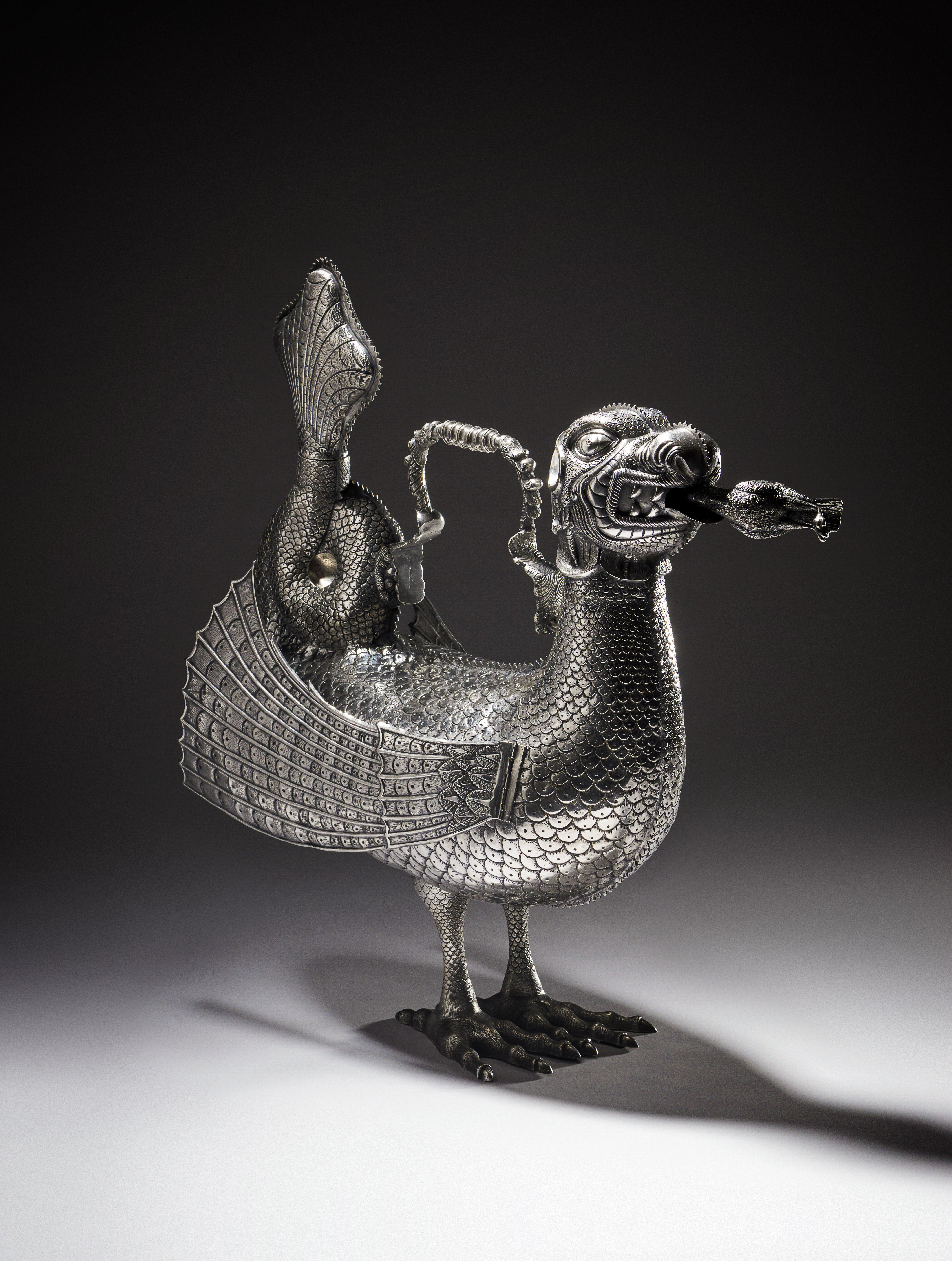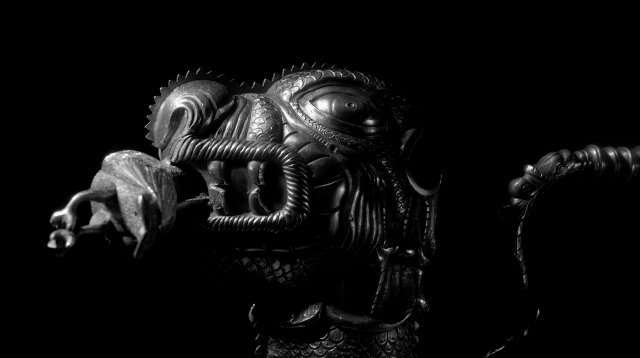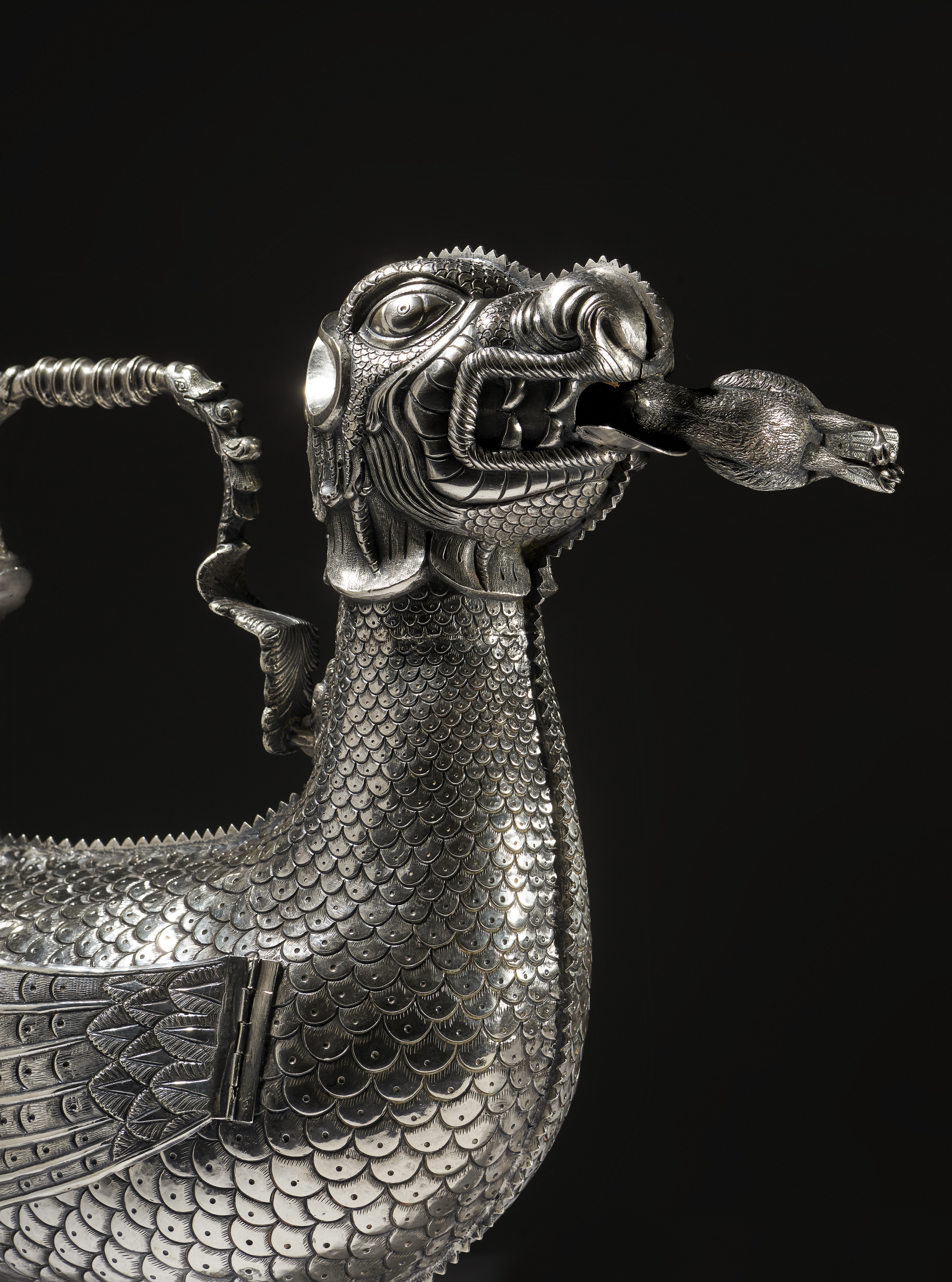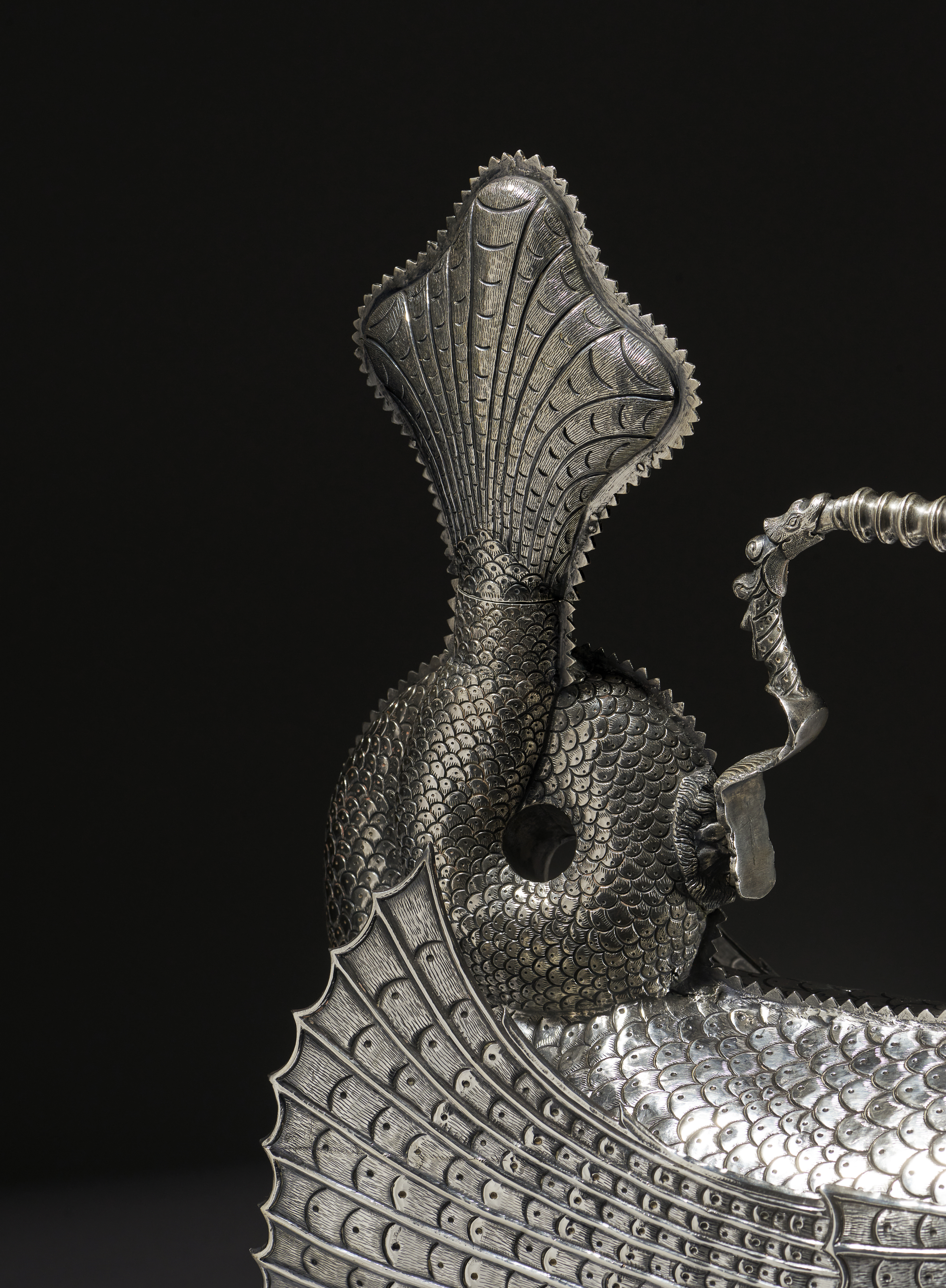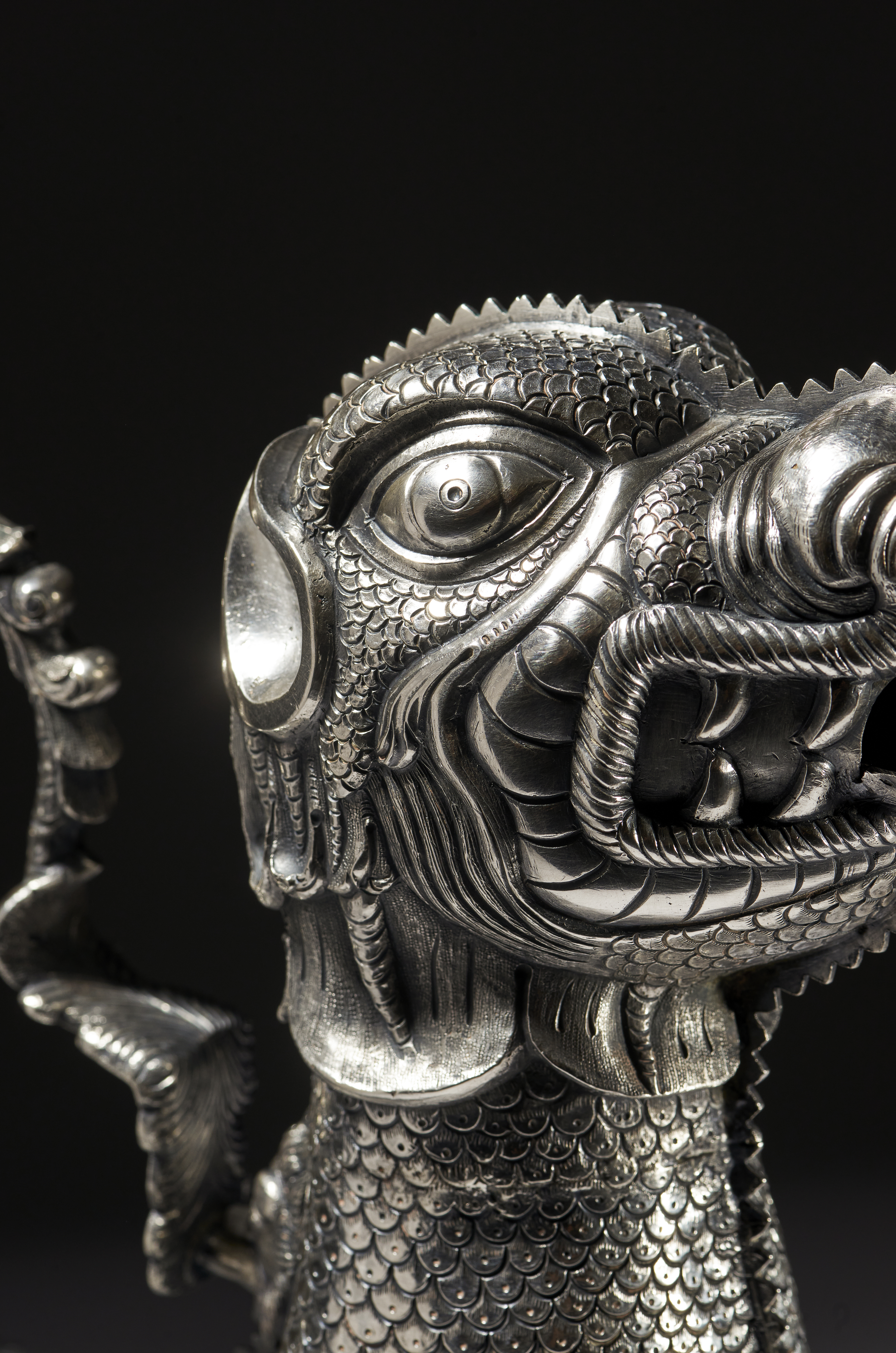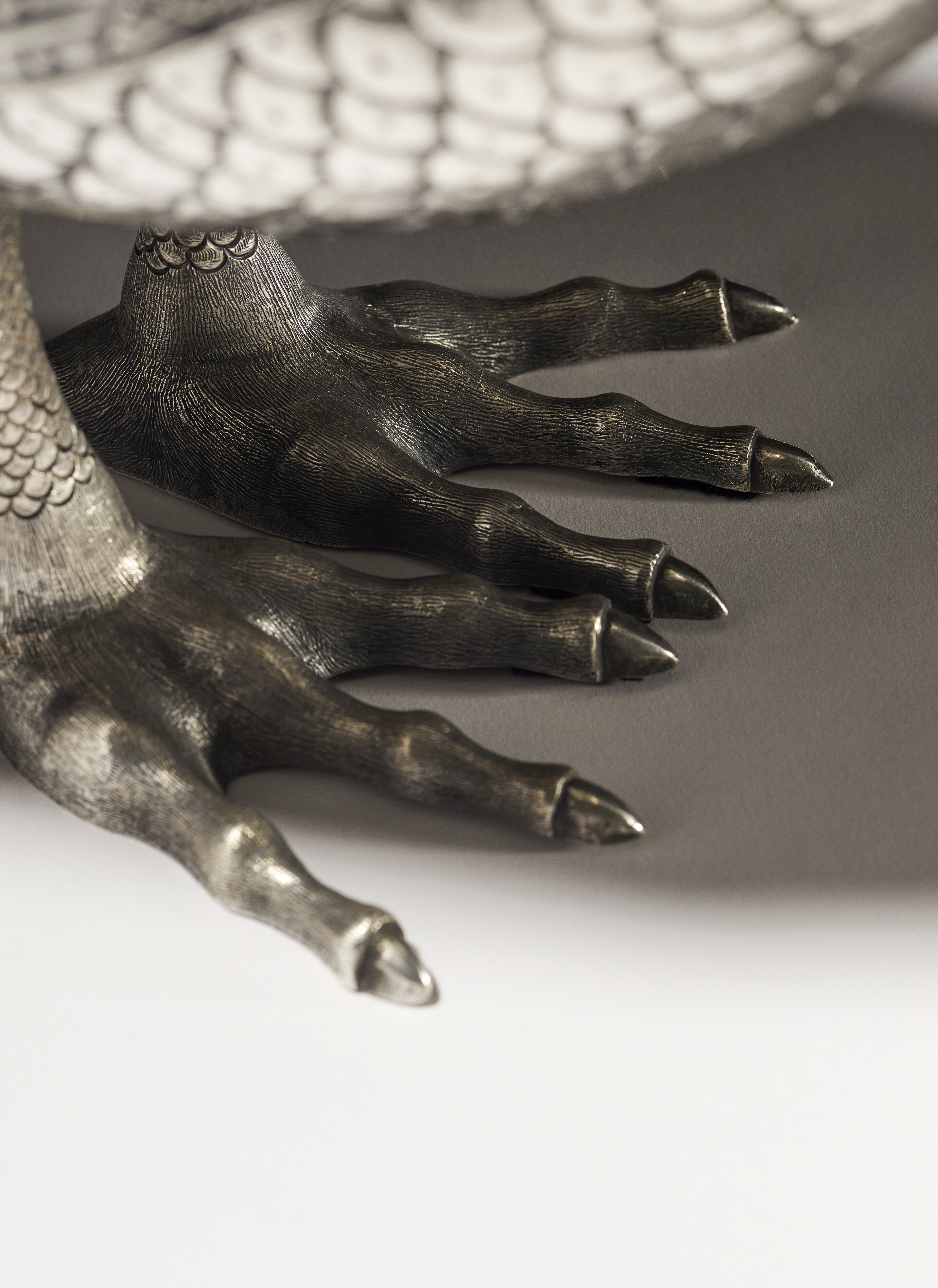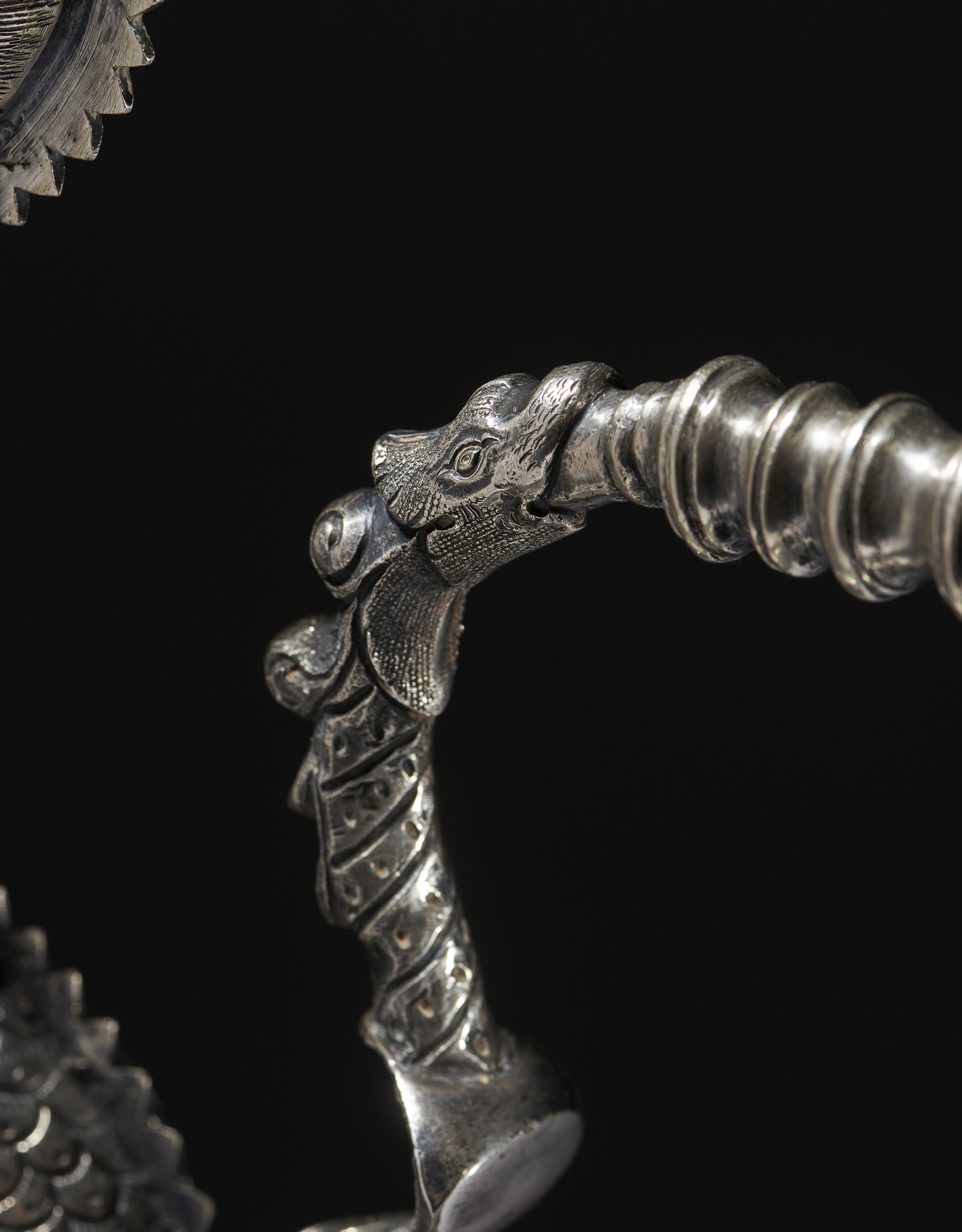124
Aquamanile (Caquesseitão)
Estimate
80.000 - 120.000
Session 1
27 May 2024
Hammer Price
Register to access this information.Description
Silver
Zoomorphic sculpture of fish scales decoration
Removable wings and coiled tale finial
One handle
On claw feet
South China or Southeast Asia
17th century (first-half)
(restoration to tale area, one foot dented, missing part of the left wing hinge, later hinge pegs)
Provenance: Collection of Pedro Costa
53x50x21 cm
5845 g
Category
Silver
THE HISTORY BEHIND AN EXTRAORDINARY AND RARE AQUAMANIL “CAQUESSEITÃO”
A silver object used at the table for the ceremonial washing of hands, this extraordinary aquamanile, large in scale and excessive in weight, belongs to a group of around ten examples, mostly from old aristocratic Portuguese collections (pub. in Crespo 2020, pp. 150-159, cat. 25). Alongside ewers (or water jugs) and basins, aquamanilia played an important role in the ceremonial life of the early modern Portuguese court as they did in other European courts, where they were used for the ceremonial ablution of the hands called água-às-mãos, both before and after meals. Worked in fine repoussé and chased, they are almost invariably constructed from two thick sheets of silver soldered at the centre with their joints very often worked with files and featuring an unusual chimerical form. This shape, which recalls medieval aquamanilia in the form of fantastic animals – for ritual usage on the Eucharistic altar and at the table of the princeps –, in turn descending from prototypes of Near-Eastern and Byzantine origin, has been identified as depicting a mythical animal described by Fernão Mendes Pinto in his Peregrinação (1614). The animal is described while referring to the kingdom of Bata in the north of Sumatra, the land of the Batak: We also saw here a new, strange type of animal, which the natives call Caquesseitão, with the size of a female duck, pitch black in colour, conch-shaped back, a row of thorns along the spine with the size of a quill pen, bat-like wings, snake-like neck, cockspur-like claw on the front of the head, a very long tail tinted green and black as the native-born lizards. These flying, jumping animals, hunt monkeys and other animals [that live] on top of trees, from which they subsist (Pinto 1616, fol. 14)..
However, the animal described neither corresponds exactly to the shape of our aquamanilia, nor does such a literary based association proves useful. What is depicted is a dragon motif widely employed in European art from at least the late fifteenth century and which therefore predates Mendes Pinto’s literary description of the fantastic animal. It is not surprising that such iconography can be found on Kunstkammer objects also predating the Peregrinação, given the fantastic nature of the animal depicted. Among these stand out the ewers, vasi (aquamanile) and some tazze, all intended for display on ceremonial tables or to be treasured in princely Kunstkammern, with their extravagant chimerical forms carved from rock crystal in workshops in Milan and Prague and set with precious gold mounts.
Similar to these display pieces, the silver aquamanilia, the majority of which have an unequivocal relationship to Portuguese collections, are covered in rounded scales, have a dragon’s head and a serpent’s tail coiled into a fish tail finial (with an opening to allow the water in), bird claws, wings with membranes similar to those of a bat, covered in scales and articulated, with a swivelling handle on the dorsal section (turned and decorated with dragons and acanthus), connecting the head to the tail, and a small bird in the mouth from which the water pours. Small differences between the extant examples are related to the positioning of the wings, the presence or absence of spikes in the snout and forehead of the dragon, the finial of the tail (lid and its screw) and the subsequent modifications that some of these pieces have since undergone; such as being transformed into water heaters. Unfortunately, these pieces have not thus far been identified in any contemporary documents, while it is certain that these would have not been recorded as caquesseitão but rather as aquamanilia (fontes).
Despite being a representation of a dragon similar to many others in European art of the same period, it is clear that the depiction of the head is Asian in character, an aspect which has already been noted in previous scholarship, drawing parallels with the dragon-fish as depicted in Chinese art from the Liao dynasty (907-1125), namely with some ceramic bottles – water droppers used for the preparation of ink (see Lopes 2019, p. 142). The head of the dragon on our aquamanilia closely follows those of the mythical dragon-crocodile, or makara, of remote Indian origins that emerges in an enormous variety of chimerical forms (see Robins, Bussabarger 1970; Darian 1976; and Salviati 1997-1999). The first Chinese representations of this mythological creature within a Buddhist context, known a mójié, show them as inhabitants of the oceans, with enormous mouths and eyes, strong teeth, long bodies covered in scales and ending with fish tails. Interestingly, the very difference already mentioned between the aquamanilia, such as the presence of a spike on the snout, point to sexual differentiation between the various objects which is similar to its representation as a makara in Chinese art (Salviati 1997-1999, p. 242). This means, therefore, that the present aquamanile is one of the existing females. From the Tang dynasty (618-907) onwards the dragon-fish, a mixture of a terrestrial and aquatic creature, is depicted with wings, being often associated with the “flaming jewel” of Buddhism. This type of representation would persist in Chinese art for a great period of time, particularly in ceramic roof tiles.
Another association that may be posited relates to the tāotiè mask, a common representation on Chinese archaic ritual bronze vases, consisting of a zoomorphic mask depicting the archetypal figure of the glutton (Kesner 1991). Significantly, during the Ming dynasty (1368-1644), the tāotiè is depicted as a creature that is fond of the sea and is deployed as a warning whenever eating or drinking to excess and is therefore a signal for moderation – a fairly appropriate figure for the decoration of an aquamanile used for the ceremonial ablution of the hands before and after meals. Furthermore, in a list of traditional motifs present in Chinese architecture entitled Lóngshēng jiǔzǐ or The Nine Children of the Dragon, in particular in a well-known version by Yang Shen (1488-1559), this mythical figure is thus described: The taotie likes to eat and drink; it used to appear on the surface of the dings [e.g. the tripod cauldron for the preparation of food and ritual offerings]. In the case of the aquamanilia, the depiction as tāotiè becomes clear in the representation of the voracious dragon that devours, in several of the examples, small birds, that extend to limit the normal flow of water for the hand washing ceremony. Such a depiction is however not related to the feeding habits of the animal caquesseitão, as has previously been assumed, given that according to Fernão Mendes Pinto, this creature feeds solely on monkeys. The excessive weight of the aquamanilia and some of their iconographic features helps us posit South China as the probable area of production, since Chinese precious metalwork is notorious for its unrestrained use of silver in contrast with Indian traditions. Another possibility is that it was made by a Chinese artisan, or within sphere of influence of Chinese art, in some region of Southeast Asia.
One aspect which needs to be answered regards the intentionality and exact meaning of its iconography, given that the number of surviving examples clearly points to a large commission, or at least a concerted one between several patrons over the same period. Considering the time in which they are thought to have been produced, it is important to underscore that dragons were widely deployed during the Restoration period which saw the end of Spanish rule in Portugal, and during the resistance period which immediately preceded it. The use stems from the fact that the crest of the Portuguese coat of arms is in fact a dragon, or a winged serpent with bat-like wings, as it is often also depicted, and stands as a symbol of the kingdom. Two engravings from this same period help us understand the reason behind the iconography. While the title page of Philippus prudens (1639) de Juan de Caramuel y Lobkowitz depicts the crushing of the Portuguese dragon by the triumphant crowned lion of Castile, flanked by two angels, the title page of Lusitania liberata (1645) by António de Sousa Macedo, made in response after the Portuguese Restoration in 1640, depicts a crowned dragon vanquishing a lion which is covered by a curly sheepskin. An elegiac couplet inscribed above the scene reads: Vngue Leo fisus credit teuisse Draconem, / sed quia iustus, eum iam Draco fecit ouem. // Hoc docet exemplum breuiter violenta perire, / solaque in aeternum viuere iusta solent, or in English translation, The overconfident lion believes he nails the dragon in place with his claws; but the fair dragon turns him into a sheep. This brief example show us that violence is bound to end, and only righteous living can make us live forever.
Curiously, the only comparable pieces to these aquamanilia are some large water heaters (‘pavas con hornillo’) of South American, probably Peruvian, depicting crowned lions. We may speculate as to whether these pieces, whose symbolism may be interpreted in the terms described above, were taken to Asia by a Portuguese nationalist. Even if the Macao Senate always attempted to act in an autonomous way regarding the governance of the archipelago, and to separate itself from the central power appointed by Lisbon, it is possible that the production of these curious domestic silver objects, of such a greatly symbolic weight as the depiction of power, represents a silent resistance to the rule of the Spanish kings. Macanese commercial strategies in the region were disrupted by Spanish power, but it also acted as an effective and military resistance to the Dutch forces that posed a constant threat after 1601 and particularly in the 1620s, as a result of the dynastic union between Portugal and Spain (see Loureiro 2007, p. 219).
Of the various known examples (around nine or ten), four are in Portuguese private collections, and two of which are now in Porto. One, a female with a bird in its mouth (44.0 x 47.0 cm; 4,746 g), exhibited in Lisbon at the Museu do Oriente (2014-2015), was sold at auction in Lisbon in 2000; it came from the collection of Francisco Manuel Cid Pereira Coutinho, and was later in the collection of Mário Roque, Lisbon (Crespo 2014, 161-169, cat. 168). A second one, a female without a bird in its mouth (46.4 x 50.5 cm; 4,737 g), had been in the United States of America in a private collection in Northumberland County, Virginia, having left Portugal in the 1970s, and was recently sold by the Peyton Wright Gallery in Santa Fe. One other, a male with a bird in its mouth – which was at some point converted into a water heater, but later reversed – belonged to the collection of José Maria Jorge, Lisbon. The present example, a female with a bird in its mouth, belonged to the collection of Pedro Costa, Lisbon, and as such was published in 1974 by Reynaldo dos Santos and Irene Quilhó (Santos, Quilhó 1974, p. 82, fig. 80).
One other aquamanile is believed to be in Brazil, having left Portugal in the 1980s. Another example, a male with a bird in its mouth, was sold in Lisbon in 1994; its present whereabouts unknown. The single example in a public collection, a male without a bird in its mouth (45.0 x 41.0 cm), having belonged to the collection of Mayer Carl von Rothschild (1820-1886), was bequeathed in 1922 by his eldest daughter Baroness Adèle von Rothschild (1843-1922), to the musée de la Renaissance, château d’Écouen, inv. E. CL.20936 (Bimbenet-Privat, Kugel 2017, pp. 52-53). It is likely that the similar male example, without a bird in its mouth, that once belonged to Prince Felix Felixovich Yusupov (1887-1967), and which is known from a 1925 photo of his jewellery and silver collection, is the same (male) that belonged to the collection of King Fernando II of Portugal (1818-1885), and that was sold in 1892 at auction as lot 2366. Known only from a photograph, this last example is now understood, based on recent archival research, to be a nineteenth-century version, earlier than 1866, modelled after the aquamanile then in the possession of the Count of Bertiandos, Sebastião Correia de Sá Meneses Brandão (1818-1874). According to the king’s post mortem inventory, it measured 46.0 x 41.0 cm and weighted 7,625 g. In the king’s own words, it had been made to order in Braga and gifted by the second count of Bertiandos (Xavier 2022, pp. 234-236).
This last aquamanile is the most famous example; a male without a bird in its mouth (47.0 x 44.5 cm; 5,058 g), then at the Palace of Biscaínhos in Braga and in the possession of the second count, passed as a treasured heirloom in the same family, that of the Marquesses of Alegrete, over several generations. Despite technical advice to the contrary, its export was authorized and sold at auction in Paris (June 26, 2013, lot 242). It was then acquired by Sheikh Hamad bin Abdullah Al Thani, a member of the ruling family of Qatar, and recently sold as part of the interior decoration of the Hôtel Lambert, Paris (12 October 2022, lot 310). Despite its prestigious provenance, it was transformed, probably in the eighteenth century, into a kettle (water heater with an interior brazier) or “pava de hornillo”, similar to later examples in the shape of a lion, or other animals, produced in South America under Spanish rule, particularly in Peru. It was exhibited in Lisbon in 1955 (and also in Paris, 1954-1955) and again in 1983. In 1955, this aquamanile, together with another, probably the one that belonged to José Maria Jorge, was correctly identified as a simple dragon (Santos et al. 1955, p. 43, no. 112, and no. 113, fig. 55). It was recently presented in Maastricht at the most important international art fair, with an asking price of over half a million Euros.
Unlike the Bertiandos-Alegrete example, our aquamanile, which remained in the same family for many decades, is preserved in its original form, having never been altered or mutilated. It was part of the important collection of works of art amassed by Pedro Rodrigues Costa Jr. (1870-1958), son of the founder of Loja das Meias, Lisbon, a great collector in his own right, and later that of his son Pedro António Costa (1933-2023).
Hugo Miguel Crespo
Centre for History, University of Lisbon
Closed Auction


